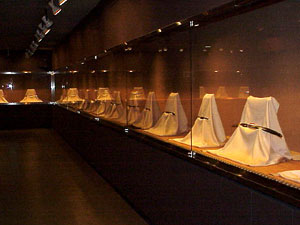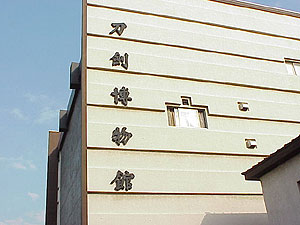
|
NBTHK
Nihon Bijutsu Token Hozon Kyokai
- The Society For The Preservation of The Japanese Art Sword
|
Japan - Main Branch: http://www.touken.or.jp/
European Branch: http://www.nbthk.net/
American Branch: http://www.nbthk-ab.org
As some of you have learned, Mr. Tanobe and Mr. Kobayashi have resigned their position at the NBTHK and are now enjoying full time retirement. Both Mr. Tanobe and Mr. Kobayashi had worked at the NBTHK for forty years, and had actually retired in 2007 which is mandatory policy upon reaching the age of 60. However, they both agreed to work on a part-time basis under an annual contract to assist the NBTHK with the workload of shinsa and research. During their tenure at the NBTHK, they have both made invaluable contributions to the study of Nihonto and Kodogu as experts in their respective fields and the magnitude of these contributions to the international study and appreciation of these art objects cannot be overemphasized. Without the support and assistance of Tanobe-san, it is doubtful that permission would have been granted for the formation of the American Branch.
|
|
"Japanese sword has been one of the
most important and respected culture in Japan. We pay great respect to
our ancestors who have kept a mind pursuing artistic significance as
well as developing practical function. We believe that we have
responsibility to take over this national asset to the next generation
and help people in the world understand its beauty. Also we strongly
feel we have to take necessary action to conserve Japanese sword in the
right way." NBTHK Tokyo
|
After WW II the Allied Forces ordered the confiscation and destruction of all Japanese weapons, and this included Japanese swords. It was only through the intervention of Col. Cadwell that art swords were preserved. The NBTHK was founded in Tokyo in 1948 through the efforts of Dr. Homma and Dr. Sato. They feared the total destruction of one of Japan's cultural heritages. Currently the Japanese art sword represents the greatest number of all registered Japanese National Treasures and Important Cultural Properties. The mission of the NBTHK was to separate, register and preserve the art swords from the bulk of confiscated weapons. Every Japanese sword, whether it comes from abroad or is discovered in Japan, must be presented to the Tocho, a panel of experts who will issue a license which must be kept with that sword at all times. If a sword is not licensed and registered, it is subject to confiscation, and the penalties for possession may be severe. |
Exhibit Area at The Token Hakubutsu Kan Exhibits include some of best swords, koshirae, armor, and tosogu in world. The exhibits are changed monthly.
Example of a Tokubetsu Hozon Kanteisho
|

|
Token Hakubutsu Kan 4-25-10 Yoyogi, Shibuya-ku Tokyo 151-0053, Japan
|
In the past, as today, the NBTHK has had the following aims: . To preserve the Japanese art sword. . To promote the understanding of, and to disseminate knowledge about, the art sword. . The recognition, classification, registration, and certification of Japanese swords. . To encourage the study of the Japanese sword and all the related arts. |
|
The Activities of the NBTHK
|
| The NBTHK, which is headquartered in
Tokyo, has 90 branches in Japan, but only two branches outside Japan,
the NBTHK European and American Branch. It pursues its constitutional
aims through:
1. Registration, Classification, Documentation and Study of the Japanese art sword. 2. Operation of a tatara smelting
furnace to produce tamahagane, the highly specialized steel suitable for
forging Swords. 3. Running of contests for
sword smiths, polishers and the other artesian of sword fittings. 4. Seminars for the study of the
sword. 5. Publishing a monthly journal
Token Bijutsu with analyses and presentations of important swords,
tosogu, smiths, methods of manufacture, hints for care of swords,
announcements of new publications, advertisements for sword dealers, and other topics. 6. Yearly exhibitions giving the
possibility of "hands-on" study of swords. 9. Permanent and changing exhibitions of important swords at The Sword Museum.
|
|
NBTHK European
& American Branch
|
| The center of the activity of the
NBTHK is of course in Japan, but the NBTHK Branches in Europe and
America are the only ones outside that country and it offers collectors
the fullest possible support and possibilities for learning with: ï American Branch: Meetings at the Tampa and San Francisco sword shows: NBTHK/AB - http://www.nbthk-ab.org - Hands-on kantei of important swords - Information on, and oshigata of, kantei items - Lecture on, and explanation of, the kantei swords - Displays of important swords - Displays of tosogu - Publication of catalogues of AB/NBTHK displays - International dissemination of information on stolen swords ï European Branch: Bi-monthly meetings in ever-changing locations in Europe. ï Study-courses and kantei ï Lectures ï Hands-on study of important swords ï Reports on sword-related studies ï Guidance and hints on proper care, storage, and handling. ï Extensive impartial advice and opinions on every sort of question, regarding the sword and its fittings, polishing, obtaining papers etc. ï Translations of the most important parts of the monthly journal Token Bijutsu into the English
language. The NBTHK is acutely aware of its
special obligations, and those of every collector, to ensure the
transmission of these extraordinary blades unharmed into future
generations. Improper care or handling, and
especially ignorant cleaning and attempts at polishing, have done
irredeemable harm to many a formerly good Sword. This sort of treatment
may render it impossible to restore, and worthless. Conversely, a minor blade will never become an art sword, even with the best polish.
"When examining a Sword it is
customary first of all to thank the previous owners for having
treasured the blade and handed it down to succeeding generations. It
is also proper to bow in a sign of respect for both the Sword and
its owners." Kokan Nagayama
The Connoisseurs Book of the
Japanese Sword 1997; 308 (Kodansha )
|